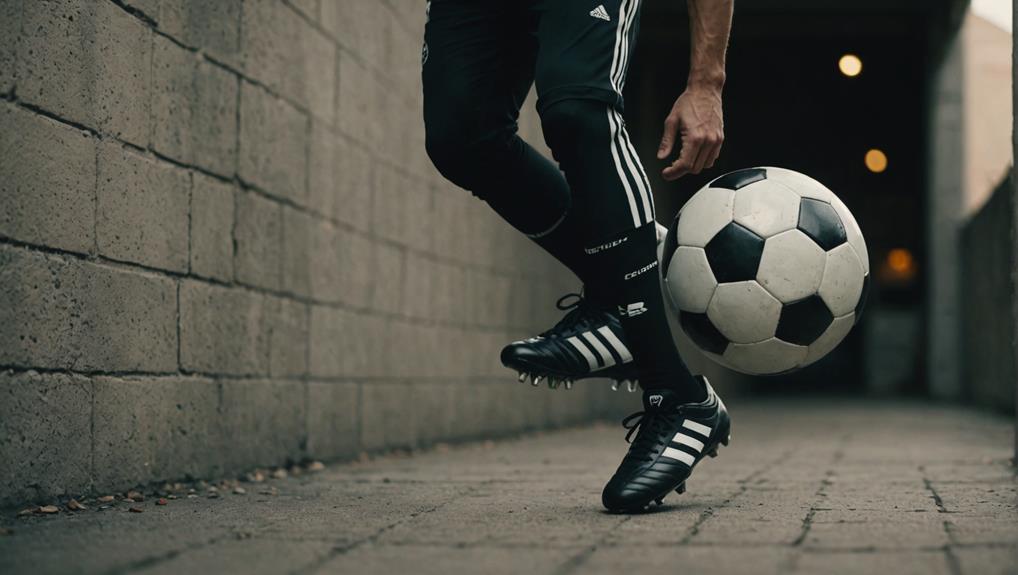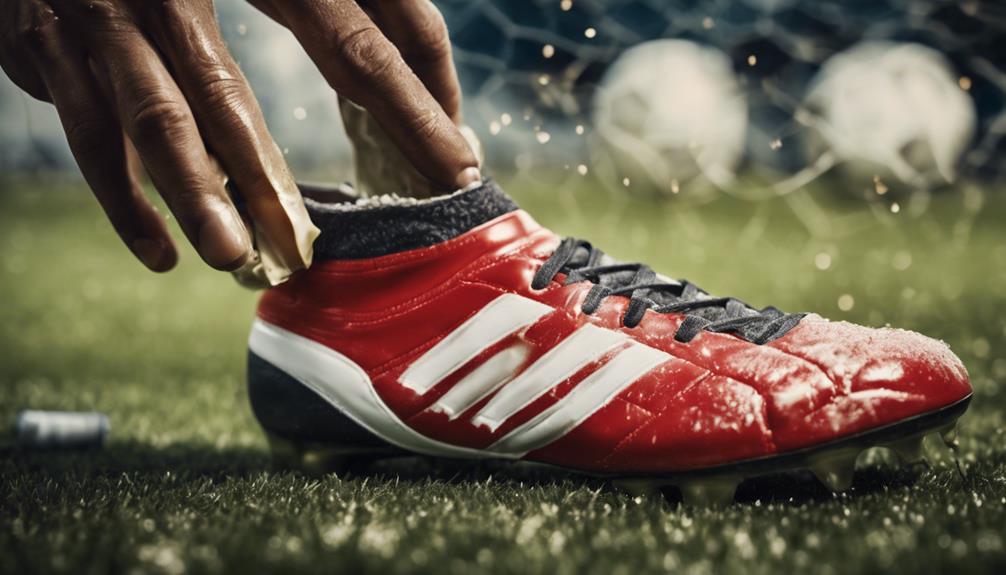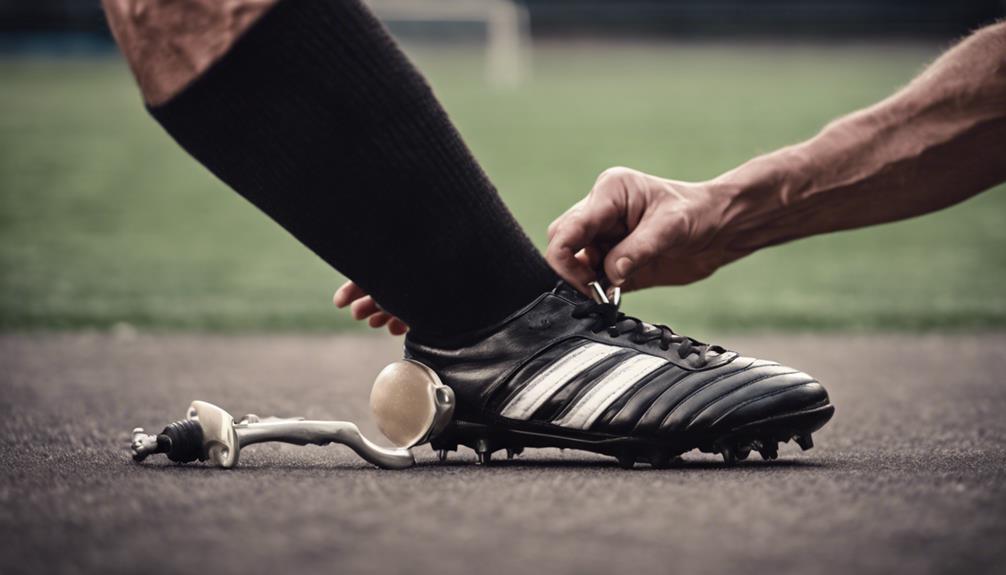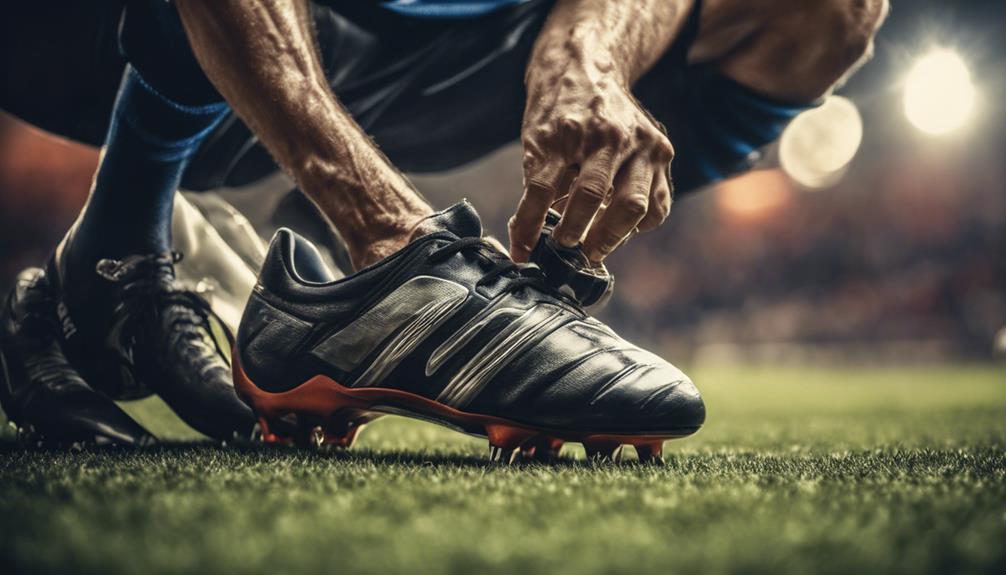
How to Break in Soccer Cleats Quickly and Effectively
July 28, 2024To break in soccer cleats quickly and effectively, start by opting for a snug fit slightly smaller than your regular shoe size, ensuring a skin-tight feel with a bit of wiggle room for your toes. Soak your feet in warm water for 20 minutes, then gently massage them while submerged to loosen tight spots. Walk or jog in damp cleats to mold them to your feet, potentially adding petroleum jelly to the leather for extra flexibility. Discover additional tips, including using thick socks, a shoe stretcher, and good insoles for support and comfort.
Choosing the Right Size
When selecting soccer cleats, make sure you choose the right size for a comfortable and secure fit. Soccer cleats are typically half a size smaller than regular sneakers to guarantee a snug fit that prevents discomfort and blisters while playing. It's important to follow the manufacturer's sizing guide for accurate measurements to find the perfect pair of cleats for your feet. Keep in mind that some brands or models may require adjustments in sizing, so always try them on before making a purchase.
To guarantee the ideal fit, aim for a skin-tight feel with just a slight wiggle room for your toes. This balance ensures that your feet are secure within the cleats while still allowing flexibility for movement on the field.
Getting Your Feet Wet
To prepare your soccer cleats for best comfort and fit, start by getting your feet wet before wearing them. Soaking your feet in warm water for about 20 minutes can help relax tight areas and assist the cleats in molding to your feet more effectively.
While soaking, gently massage your feet to further loosen any tight spots and enhance the molding process. The hot water will soften the material of the cleats, making them more comfortable to wear.
After soaking, you can wet fit your cleats by walking or jogging in them while they're still damp. This can help speed up the breaking-in process. Additionally, consider applying petroleum jelly to the leather of your cleats before wet fitting. This will help maintain the softness of the material and reduce the risk of blisters.
Applying Petroleum Jelly

When breaking in your soccer cleats, consider applying petroleum jelly.
This quick lubrication method offers various benefits to your cleats. It helps maintain the leather quality, reduces discomfort, and aids in molding the cleats to your feet for a better fit.
Quick Lubrication Method
Consider enhancing the breaking-in process of your soccer cleats by applying a layer of petroleum jelly to reduce friction and prevent blisters. This quick lubrication method is particularly beneficial for leather cleats, as it helps soften the material and mold it to the shape of your feet.
By keeping the leather supple and flexible, petroleum jelly aids in making the breaking-in period more comfortable.
Additionally, applying petroleum jelly before wearing wet cleats can further enhance the molding process. This cost-effective and convenient technique not only speeds up the break-in time but also maintains the quality of your leather cleats.
Combining this method with others like wet fitting and stretching can result in a personalized and comfortable fit for your soccer cleats. Try incorporating petroleum jelly into your cleat maintenance routine for a quick and effective way to break them in efficiently.
Benefits of Petroleum Jelly
Using petroleum jelly on your soccer cleats offers various benefits that can improve the breaking-in process and enhance your overall comfort on the field. Applying petroleum jelly helps maintain the leather's softness and flexibility, reducing the likelihood of blisters as you break in your cleats.
The petroleum jelly aids in molding the leather to your feet, making it easier for the cleats to conform to your foot shape. When walking or running in damp conditions after applying petroleum jelly, the leather becomes more pliable, allowing for better customization to your feet.
Moreover, the petroleum jelly acts as a protective layer between your skin and the cleats, decreasing friction and discomfort while ensuring a smoother break-in period. By incorporating petroleum jelly into your breaking-in routine, you not only enhance your comfort but also extend the lifespan and performance of your leather soccer cleats on the field.
Walking or Jogging in Wet Cleats
When your cleats are wet, take advantage of the opportunity to walk or jog in them.
The moisture helps the cleats mold to your feet more effectively, ensuring a better fit.
This method can speed up the breaking-in process and enhance comfort while playing.
Wet Cleats Walking
Walking or jogging in wet cleats aids in molding the material to your feet more effectively, expediting the breaking-in process by softening the leather or synthetic materials. The moisture from wet cleats allows them to stretch and conform to your foot shape, enhancing the overall fit.
To break in your cleats using this method, wear them with socks while walking to prevent blisters and discomfort. Wet cleats walking is a common technique employed by athletes to accelerate the comfort and fit of new soccer cleats.
By taking advantage of the moisture in the cleats, you can help the synthetic materials adjust to your feet quicker, making the breaking-in period more efficient. Remember to gradually increase the duration of wearing wet cleats to prevent any potential rubbing or irritation on your skin.
Embracing wet cleats walking can significantly enhance the overall feel and performance of your new cleats on the field.
Jogging in Damp Cleats
Jogging in damp cleats can greatly expedite the breaking-in process by effectively molding the material to your feet. The moisture present in damp cleats softens the material, increasing its pliability and comfort.
Walking or jogging in wet cleats enhances flexibility, reducing the likelihood of developing blisters. By conforming the cleats to the shape of your feet, this method remarkably improves overall comfort and performance on the soccer field.
It's recommended to engage in jogging with damp cleats for 30 to 60 minutes to efficiently hasten the breaking-in period. This technique not only accelerates the process but also customizes the cleats to your feet, ensuring a snug and personalized fit.
Embracing the dampness in your cleats while jogging is a practical approach to achieving excellent comfort and functionality during gameplay. Give this method a try to break in your soccer cleats swiftly and effectively.
Properly Drying Them Out
To effectively dry out your soccer cleats after each use, remember to stuff them with newspaper to absorb moisture and maintain their shape. This step is essential in the drying process as it helps prevent the accumulation of moisture within the cleats, which can lead to mold, odors, and bacterial growth.
By allowing the newspaper to absorb the moisture inside the cleats, you're also aiding in preventing leather cracking and maintaining the overall integrity of the cleats for a longer period.
It's important to note that direct heat sources such as sunlight or air ducts should be avoided when drying out your cleats. These sources can damage the materials of the cleats, affecting their performance and durability.
Properly drying your cleats after each use not only helps in preventing potential issues like mold and odors but also plays a significant role in preserving the quality and longevity of your soccer cleats.
Using Lubricant for Training
How can lubricant enhance your training experience with new soccer cleats? Petroleum jelly can be a game-changer for soccer players looking to break in their cleats quickly and effectively during training sessions. Here's how it can help:
- Reduces Friction:
Applying petroleum jelly on pressure points reduces friction between your skin and the cleats, preventing blisters and discomfort.
- Softens Cleats:
Lubricants help soften the material of the cleats, making them more pliable and comfortable to wear.
- Molds to Feet:
By reducing friction, petroleum jelly aids in molding the cleats to the shape of your feet, enhancing the overall fit.
- Comfort and Efficiency:
Incorporating lubricant into your training routine can make the breaking-in process smoother and more comfortable, allowing you to focus on your performance.
Remember to keep an eye on your comfort levels and reapply the lubricant as needed to secure a positive training experience with your new cleats.
Stretching the Uppers

Wondering how you can effectively stretch the uppers of your soccer cleats for a more comfortable fit? To start, wear your cleats with thick socks and walk around in them for extended periods to soften the material.
For targeted stretching, use a shoe stretcher to address specific tight areas on the uppers. Gradually increase the stretching pressure for best results. Additionally, consider applying a stretching spray designed for leather cleats. This spray helps soften the material, making it more pliable for a comfortable fit.
Another method is to stuff your cleats with a damp towel or cloth to stretch out the uppers, focusing on areas like the toes and sides where tightness is felt. You can also use a hairdryer on a low heat setting to warm up the uppers before gently stretching them with your hands for a customized fit.
Investing in Good Insoles
Invest in quality insoles to enhance the comfort and support of your soccer cleats, improving your performance on the field. Here's why investing in good insoles is important:
- Personalized Comfort and Support: Custom insoles provide tailored support, reducing strain on your feet and lowering the risk of injuries.
- Proper Foot Alignment: Insoles with arch supports help align your feet correctly, enhancing overall performance and minimizing discomfort during play.
- Shock Absorption: Good insoles act as shock absorbers, lessening the impact on your feet and increasing your comfort while running and kicking.
- Prolonged Cleat Lifespan: Quality insoles not only boost comfort but also extend the life of your cleats by offering extra cushioning and support for prolonged use.
Investing in the right insoles can make a significant difference in how comfortable and supported your feet feel during matches, ultimately impacting your performance on the pitch.
Care and Maintenance Tips

Regular care and maintenance of your soccer cleats is crucial for preserving their performance and longevity on the field. To guarantee your cleats stay in top condition, clean them after each use with a soft brush to remove dirt and debris.
For synthetic uppers, use a wet cloth with mild soap, and for leather uppers, opt for a leather cleaner. Proper cleaning not only maintains their appearance but also extends their lifespan.
When not in use, store your cleats in a dry place away from direct sunlight to prevent mold and odors. Avoid wearing them on hard surfaces like concrete to prevent premature wear and damage to the studs.
Conclusion
Now that you've learned the tricks to break in your soccer cleats quickly and effectively, you'll be scoring goals in no time. Remember to choose the right size, get your feet wet, and use lubricant for training.
By taking care of your cleats and investing in good insoles, you'll be on your way to dominating the field.
So lace up those cleats, hit the pitch, and show off your skills!


